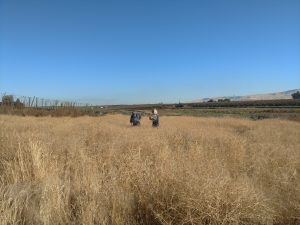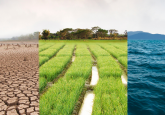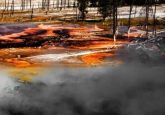The soil microbiome: a ticking time bomb for climate change

The soil microbiome is the most diverse microbial ecosystem on the planet. There are billions of microbial cells in just a teaspoon of soil and less than 10% of these microbes have been isolated and characterized. Only now are researchers beginning to understand the enormity of the biochemical potential in the soil microbiome and the more that they uncover the clearer it becomes that this ecosystem is a sleeping giant of CO2 emissions, one that human behavior is beginning to wake…
Here BioTechniques talks to microbiome expert Janet Jansson about the carbon density of the soil microbiomes around the world, how humans are damaging them and how we can begin to turn the tide.

Please can you introduce yourself and your institution?
I’m Janet Jansson, Chief Scientist for Biology and Laboratory Fellow at the Pacific Northwest National Laboratory (WA, USA). This is a Department of Energy (DOE) Laboratory. Our particular department is in the Earth and Biological Sciences Division, which includes earth science, biological sciences and the DOE user facility, the Environmental Molecular Sciences Laboratory (EMSL).
You released a paper recently discussing climate change and the soil microbiome. Can you outline how human behaviours and climate change are affecting the soil microbiome?
Normally when we think of climate change, it’s sort of lumped into an all-encompassing terminology, but we know that climate change, if you break it down, includes a lot of different variables. One thing that we discussed in that review was how different types of climate change perturbations are impacting the soil microbiome. That can include everything from permafrost in the Arctic to fire and drought. In each of these specific types of climate change scenarios, the soil microbiome is impacted specifically to respond to those changes in their environment.
Climate change represents an indirect way by which humans are influencing the planet and therefore, soil microorganisms. More direct types of anthropogenic disturbances include any kind of landscape perturbation, such as agriculture or clear cutting. These practices are all going to have an influence on soil microorganisms.
Are there any particular regions of soil or specific microbiome environments that are particularly vulnerable to the effects of climate change?
The Arctic is experiencing warming to a greater extent than the rest of the planet, and that is definitely having an influence on the soil microorganisms in that region. One example is permafrost, which is starting to thaw. The microorganisms that are living in permafrost are not normally very active because it’s frozen. However, as the permafrost starts to thaw, those organisms start to become more active. This is problematic because the permafrost is a reservoir for much of Earth’s organic carbon, and so as the microorganisms become more active they start to decompose that organic carbon and release greenhouse gases such as CO2 and methane into the atmosphere.
Do we have an idea as to the scale of carbon that’s currently locked away inside soil microbiomes, be that in the Arctic or across the globe?
For permafrost, we have some pretty good estimates. We know that there is as much carbon trapped in permafrost as there is currently in the atmosphere and vegetation combined. That’s an enormous amount of carbon and if you look at it on a global scale, much of the carbon is residing in the Arctic in these frozen soils. Another area where there are high concentrations of carbon is in grasslands, such as prairies, where the carbon has accumulated over time in these rich organic soils.
Are there any additional ways that soil microbiomes are reacting to climate change that may also impact the environment that they reside in?
The soil microorganisms carry out many important functions for ecosystems, primarily by supporting the growth of plants. In addition to breaking down organic carbon as I discussed, they also cycle nitrogen to make it available to plants and they are also responsible for cycling other nutrients. All of these different processes and functions that are carried out by microorganisms can be potentially influenced by changes that are occurring due to climate change.

Are there any additional ways that soil microbiomes are reacting to climate change that may also impact the environment that they reside in?
The soil microorganisms carry out many important functions for ecosystems, primarily by supporting the growth of plants. In addition to breaking down organic carbon as I discussed, they also cycle nitrogen to make it available to plants and they are also responsible for cycling other nutrients. All of these different processes and functions that are carried out by microorganisms can be potentially influenced by changes that are occurring due to climate change.
What technical developments have had the biggest impact on the study of soil microbiology, in the last decade?
We have benefited greatly from advances in high throughput sequencing technologies. It is now possible to rather cheaply and quickly sequence any soil sample and see if there is a change or a shift in the soil microbial community. Other practices on the horizon that are not quite as well developed include omics technologies, such as proteomics and metabolomics, that go beyond understanding the compositional shifts, to understanding how soil microbial functions are impacted as well.
When we have a clearer grasp of that function, do you envisage a way that we can start to use it to more effectively manage soil microbiomes around the globe?
As we get more understanding of how soil microorganisms interact to carry out important processes, such as cycling of carbon and other nutrients, we find that it’s very rare that one organism is responsible for a process on its own. If we understand how these microorganisms work together to cycle carbon, or nitrogen, or support the growth of plants, we can start to harness that knowledge in a couple of ways. One is to make better predictive models so that we can predict how soil microorganisms will respond to a given perturbation, such as climate change. That kind of information is good for landscape managers and farmers. The other thing that we could do, which I think is really exciting, is to harness the properties of the microorganisms themselves and make designer inoculants or somehow manipulate the environment to favor the growth of the beneficial microorganisms.
Is there currently a proposal for how that manipulation of the soil microbiomes could be implemented to serve a beneficial purpose to the environment?
There has been quite a bit of research on using soil microorganisms to promote the growth of plants, so I think that we have considerable knowledge there. Microbial inoculants have been used for a long time, for example adding rhizobia to legumes to fix nitrogen from the atmosphere, so we know that we can add certain kinds of microorganisms that are derived from soil to support the growth of plants. The current focus is going beyond that; to see if we can use different combinations of organisms to form communities that that carry out some of the more elaborate processes, such as sequestration of carbon that is captured by a plant and keeping it stabilized in soil or perhaps promoting osmo-tolerance or drought tolerance to plants.
Do you see soil microbiomes playing a large role in the future in terms of addressing world food shortages?
Yes, I think that will be critical in the future, especially as we are losing – on a planetary level – much of Earth’s fertile soils due to erosion and improper land management practices. At the same time, we have a growing world population. We are going to have to be very creative at using more marginal soils to grow crops that are needed to feed the world population. Part of that equation will need to include soil microorganisms, in order to reduce our reliance on adding chemical fertilizers and also to help plants grow in these more marginal soils.
You’ve mentioned how mistreatment of land is an abundant issue. Can you give some examples of poor land management practices and do you have any recommendations or examples of better practices that are beneficial for soil microbiomes?
Well, monoculture is a large focus in the United States, where we are losing our diversity and letting soils go fallow so that they can be eroded. But farmers are smart. They are taking recommendations to incorporate practices such as using cover crops, instead of letting the fields go fallow, which therefore prevents erosion. These are practices that are being adopted in the US and other developed countries. One area that is an example of a horrible situation is the clearcutting that’s happening in Brazil and in other countries, where you don’t have these deep rich soils to begin with and when you get rid of the tree cover it rapidly erodes and that soil is lost. That’s an extreme situation but unfortunately, an enormous problem.
What would you most like to understand better, in terms of the soil microbiome, for us to prepare for and to mitigate the impact of climate change on the soil microbiome and vice versa?
I personally think that we really need more research on the molecular level details of biochemical interactions that occur between interacting members of soil microorganisms. Soil can still be considered a relatively black box with respect to our ability to understand what soil microorganisms are doing and how they interact with each other. Although we can now sequence and understand what is there, as I mentioned before, the details of what they’re doing are still very poorly understood. Once we understand that, then we can harness the information and manipulate soil microbiomes to use their beneficial properties to our advantage.
Where do you see the field of soil microbiome research in the next 5 years?
In the next 5 years I think that we will have taken advantage of some of the omics technologies that are now available to make much better models of microbial interactions and the microbial metabolic processes that are occurring in soil. We will then be able to predict how those key interactions are influenced by different climate change variables. As we go farther into the future, we should be able to use that knowledge and those predictions to be able to harness those properties.





